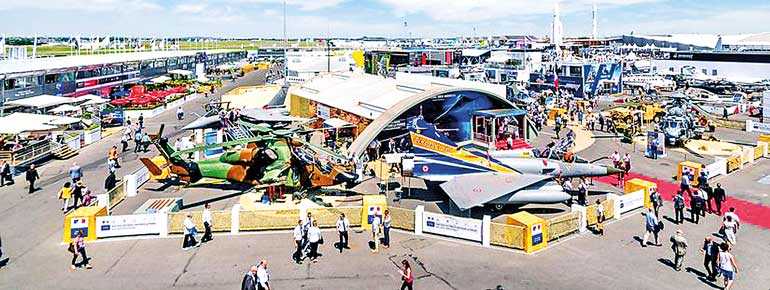Monday Nov 03, 2025
Monday Nov 03, 2025
Monday, 1 July 2019 00:00 - - {{hitsCtrl.values.hits}}

The 54th edition of the Paris Airshow concluded last week at Le Bourget Airfield. Billed as the world’s oldest Airshow, it has been held biennially since 1919, with interruptions only for the two world wars.
Airbus wins big
Airbus, celebrating its 50th anniversary, was the big winner, with the lion’s share of the 866 orders announced at the show. The latest iteration of the pioneering A320 family, the Extra Long Range version (dubbed the A321XLR) was the darling of Paris 2019, with 230 orders. 
Indigo Partners, a US investment group that controls several airlines (including Europe’s Wizz Air, the US’s Frontier Airlines and Chile’s JetSmart) ordered 50 A321XLRs. They were joined by some of the world’s airline heavyweights including the International Airline Group (IAG), American Airlines, Qantas, Saudia, giant lessor Air Lease Corporation (ALC) and many others.
The existing versions A320 and 321NEO (New Engine Option) also gained over 350 orders, but the bulk of these were from AirAsia converting 253 existing A320 orders to the larger A321s.Obviously Asia’s largest Low Cost Carrier (LCC) group sees a strong market and wants to add seats.
Airbus’s widebody stable was a poor performer, with only two customers for the A330NEO placing a total of 24 orders and six options. Interestingly there were no orders for the ‘flagship’ A350 line. The giant A380, as we know, has not sold a single unit in years and production will cease in a few years.
Airbus also saw healthy orders for the smaller A220 (previously the Bombardier C-series) with almost a hundred commitments, including a landmark order of 50 units from lessor ALC.
Boeing fights back
Still struggling with the fallout from the 737MAX debacle (discussed previously in these pages) Boeing fought back at Paris with some landmark orders.
The 787, by far the dominant ‘new’ widebody in the market, saw 25 orders. There was only one order for a passenger 777 (by Turkmenistan Airlines) but the freighter version saw 11 orders (China Airlines for six and Qatar Airways for five units) showing confidence in a healthy cargo market. There were no orders for the upgraded 777X, which is yet to fly – delayed again by engine manufacturing related issues.
The breakthrough though, was a Letter of Intent (LOI) for 200 737MAXs by the International Airline Group (IAG)– the first show of confidence since the two tragic crashes that the aircraft is safe, despite the hysteria shown in some sections of the media.
IAG CEO Willie Walsh, himself a pilot who has flown the 737, expressed total confidence in the aircraft. Walsh, who has a reputation as one of the toughest negotiators in the business, must have gotten an amazing price for the aircraft as well.
Trends
Several interesting trends became evident in Paris. One is the domination of large leasing companies (292 orders) and LCC airline groups (450+ orders).
Accipiter Holdings (a smaller Irish leasing company) and giant ALC made significant orders. Nordic Aviation Capital and Elix Aviation Capital, both specialists in regional turbo-prop aircraft, now dominate the order book for manufacturer ATR’s future production of the popular regional aircraft. AirAsia, IAG and Indigo Partners also made large orders. Interestingly, the other two large lessors Avolon and Aercap (both based in Dublin, Ireland) did not place any orders this year in Paris.
The narrowbody models (also known as single-aisle) are now easily the preferred choice of most airlines and lessors. A total of 558 narrowbody orders plus 246 regional jets and turbo-props were ordered in Paris, as opposed to just 62 widebody units. That is in stark contrast to just a few years previously.
The popularity of the Airbus A320 family, particularly the XLR, show that airline managers are focusing on cost efficiency. The dominance of the LCCs further reinforces this observation. Interestingly, the XLR will start cannibalising the market of not only Boeing’s aging 757 & 767 fleets, but also Airbus’s own larger A330s.
Capable of flying non-stop on ‘long and thin’ routes such as Colombo to Perth (Australia), Colombo-Beirut (Lebanon) or Colombo-Seoul (South Korea) the A321XLR makes it possible for airlines to open new routes which were previously not within the range of narrowbody aircraft and too small for deployment widebody aircraft, with unrivalled operating costs.
The dearth of orders for the larger widebody types must worry the manufacturers. The 787 remains the dominant type certainly, but Boeing’s cash-cow 777 (having over 2000 orders, of which 1,600 have been already delivered) is obviously at the end of its useful life and there is a worrying lack of enthusiasm for the new generation 777X.
Airbus’s A350 series is also seeing stalled orders, in part due to current users of the popular A330-family preferring the upgraded A330-900NEO, which is believed to be significantly cheaper to acquire than its bigger brother.
This suggests that the current trend in the market is to move towards ‘right-sized’ flying with smaller and more cost efficient aircraft flying longer distances, instead of moving to larger, prestige driven, and widebody aircraft. Such a switch, undoubtedly, will also see a shift of service standards – with most airlines likely to lower some frills in order cut costs and the routes more viable. Whether the orders switch to smaller gauge aircraft is a long-term or not, one thing is for certain – the airline industry shows no signs of a slowdown.